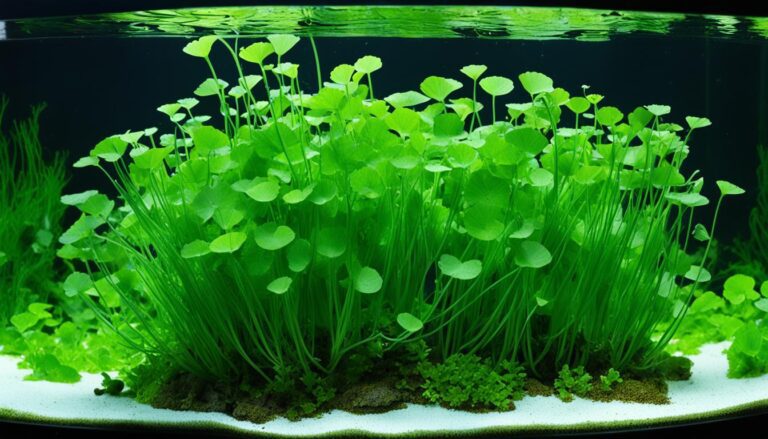Adding aquarium plants to a freshwater aquarium boosts its look and the health of the ecosystem. The Pennywort plant is a great choice. It’s tough and easy to take care of, making it perfect for all aquarists.
In my experience, Pennywort is super flexible with any aquarium setup. It does well in water temperatures from 20℃ – 28℃. It also likes pH levels from 6.0 to 7.0. This plant helps keep the water clean by reducing nitrates, which is essential for a healthy aquarium.
Pennywort is adaptable but grows best under certain conditions. It grows fast when it gets enough light. It does better than slow growers like Java Moss. I make sure Pennywort has room to grow in my freshwater aquarium. This way, it looks good without taking over.
Pennywort’s little white flowers can float to the surface, adding charm to the tank. Check out this guide to learn more about adding Pennywort to your aquarium.
Discovering the Versatile Pennywort Plant
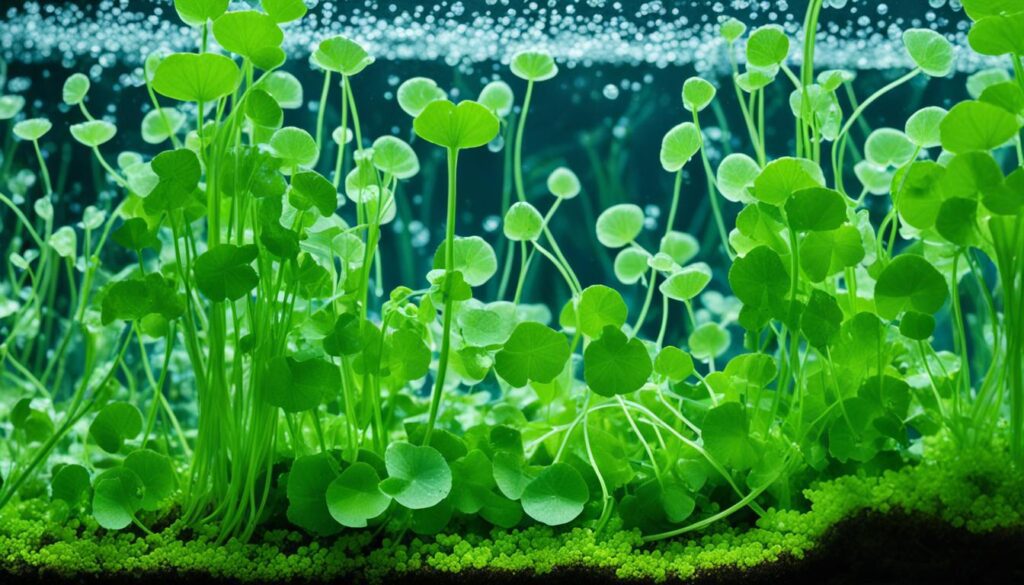
Welcome to my exploration of Pennywort, also known as Brazil Water Ivy. This plant is a top pick for aquarium lovers. Its lush, round leaves grow fast. This makes it great for both making tanks look good and helping the ecosystem.
What Is Pennywort?
Pennywort is an aquatic plant that can easily adjust to various water settings. It’s easy to take care of. Because it grows fast, you can use it to float or attach to the bottom. This makes tanks look natural and beautiful.
Multiple Names, One Plant: From Brazil Water Ivy to Pennywort
Pennywort is also called Brazil Water Ivy, among other names. Each name shows something special about the plant. No matter what name it goes by, it makes tanks look better and helps clean the water.
Property |
Details |
|---|---|
Care Level |
Easy |
Growth Rate |
Fast |
Tank Placement |
Foreground/midground, floats along substrate |
Lighting Requirement |
Thrives in low to bright light |
Ideal Temperature |
70°-86°F (18°-30°C) |
pH Level |
5-8 |
Substrate |
Yes |
Additional Features |
Provides shade, absorbs excess nutrients, offers habitat |
Pennywort: The Ideal Beginner’s Aquatic Plant
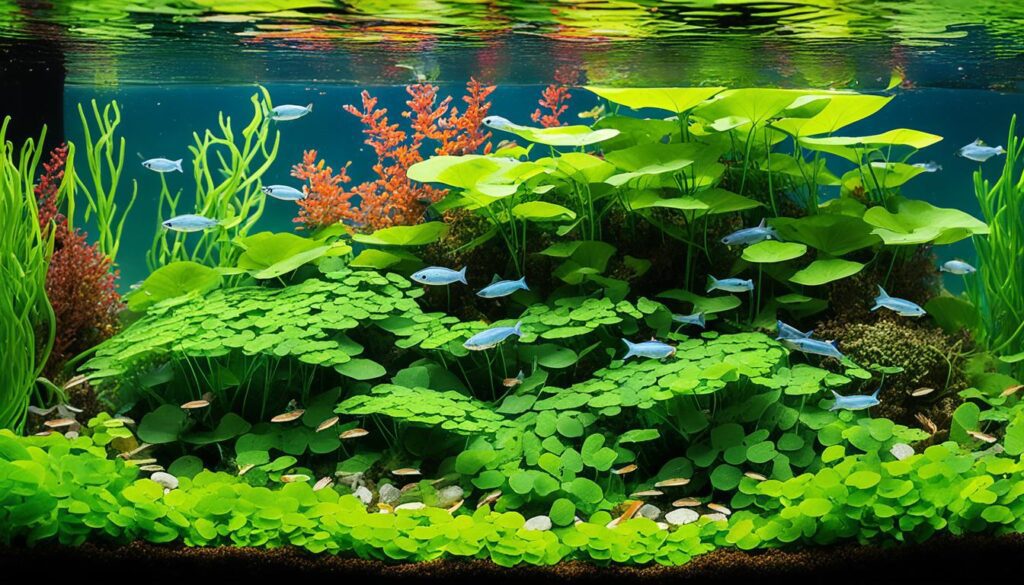
If you’re new to aquascaping, Pennywort is great for starters. It’s a beginner-friendly aquarium plant that grows well in different conditions. This makes it easier for those worried about freshwater plant care. New aquarium owners will find Pennywort’s forgiving nature and strong Pennywort growth perfect for starting out.
Pennywort comes from the lush areas of Central and South America. It does well whether it’s under the water or floating on top. It grows quickly, reaching between 15-60 cm tall.
This plant is versatile. You can put it in the back or middle of your tank. If conditions are right, it can even climb. It’s not picky about light, doing fine in low to high lighting with minimal CO2 needed.
Feature |
Details |
|---|---|
Family Name |
Araliaceae |
Color Form |
Light to Bright Green |
Water Conditions |
20-28°C (68-82°F) |
pH Range |
6.0 – 7.8 |
Max Size |
Can grow indefinitely in length; leaves up to 3 cm (1.2 inches) in diameter |
Lighting |
Low to High |
Growth Rate |
Fast |
Care Level |
Easy |
Placement |
Mid-ground to Background; can be floated |
Pennywort is forgiving and adaptable for beginners. You can try different setups without worrying about the plant dying. Whether you want a lush backdrop or a floating garden, Pennywort is solid. It’s easy to care for and improves the look and balance of your tank. It’s a top pick for anyone new to aquariums.
Selecting Healthy Pennywort for Your Aquarium

Setting up your aquarium the right way is important. Including the right plants improves your ecosystem’s health and look. Pennywort, especially the Brazilian kind, is great because it’s adaptable and easy to care for. Here’s how to pick the healthiest Pennywort, to make your aquarium vibrant with these aquatic plants.
Identifying Quality Pennywort Plants
To successfully choose Pennywort, look at the plant’s health signs. Find plants with light green leaves, which show they’re healthy. The leaves should be between the size of a dime and a half-dollar. They also need a clear vein pattern for good photosynthesis. Don’t pick plants with damaged leaves, like holes or tears. Such damage might point to health problems.
Insight into Roots and Stem Health
The plant’s root and stem condition is crucial too. Choose Pennyworts with strong, bendy stems that aren’t yellow or soft. Roots should be almost white. This shows the plant is fresh and cared for. Strong roots are important. They help the plant take in nutrients and keep it stable in the aquarium.
Knowing about Pennywort’s leaves, roots, and stem robustness is key. By picking the best plants, your aquarium will not only look better. It will also be healthier and more balanced. Keep in mind, the health of Pennywort affects your water’s quality and the life of your aquarium’s other inhabitants.
Mastering Pennywort Care in Your Aquarium
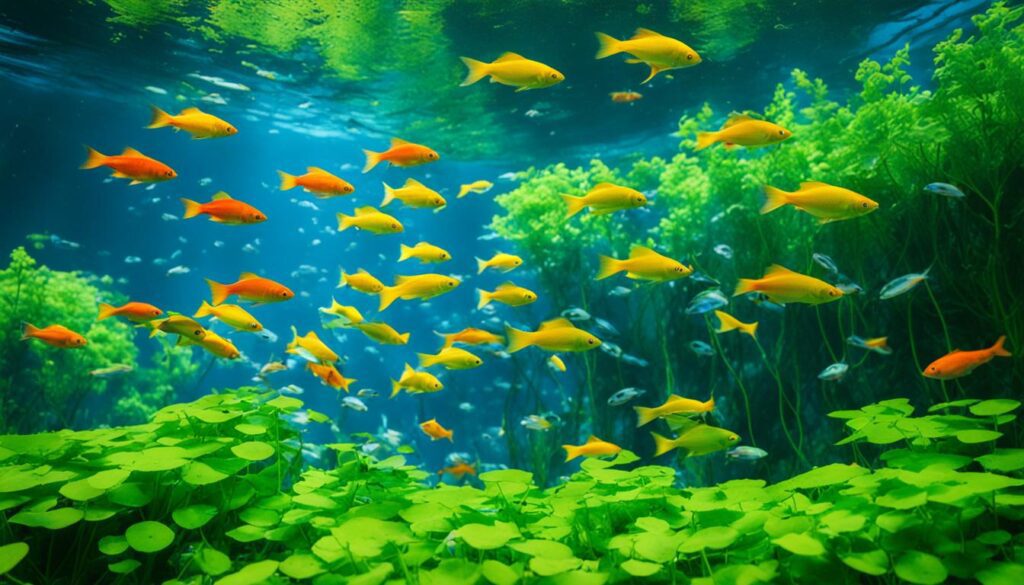
Caring for pennywort in your aquarium is key. Knowing about its growth, where to place it, and how to take care of its roots and stems is essential. I’ll share my tips and what I’ve learned from others. This will help you do well with your pennywort.
Plant Positioning and Growth Rate
Pennywort grows fast, so you need to think about where to put it. The right spot helps it grow better and makes your aquarium look great. You can have it root in the ground or let it float on the water.
Rooted pennywort spreads on the bottom and can block light, which might cut down on algae. Floating pennywort creates shade below, which is good for fish that like hiding.
Navigating Roots & Stems: Avoiding Damage
Handling pennywort carefully is important, especially when cleaning. The stems are tough but can get damaged by tank equipment or if cut too much. Watch and be gentle to avoid problems with filters or decorations. This helps your plant focus on growing, not fixing itself.
Learning from others can also improve your pennywort care. With 72K views on care discussions, many people find it important. Finding the right mix of useful and beautiful placement can make growing pennywort more satisfying. Remember these tips for healthier plants and a prettier tank.
Optimal Water Conditions for Thriving Pennywort
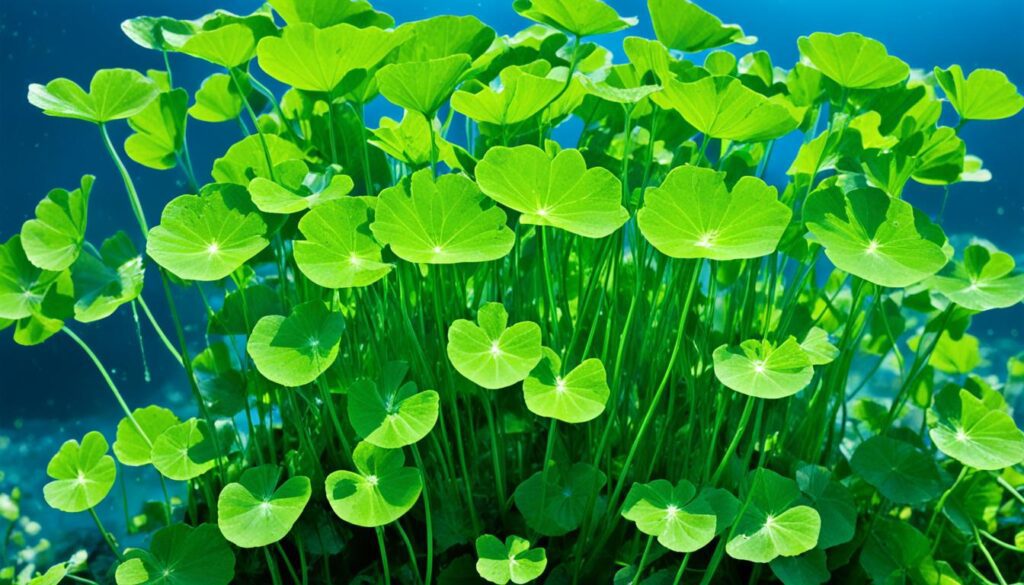
For anyone keen on keeping their aquarium in top shape, knowing the right water parameters for Pennywort is key. This plant does well in different water conditions, making your tank healthier. It’s important to get these conditions right for Pennywort to do well.
To create the best environment, it’s not just about the water temperature. You also need to keep the water chemistry balanced and the tank clean. Here’s what you need to know to help your Pennywort grow and thrive.
- Pennywort prefers slightly acidic to neutral water, with a pH range optimal at 6.5 to 7.5.
- This plant is well-suited for shallow, boggy environments and requires at least 10cm of water depth.
- To mimic natural habitat conditions, it benefits from being in locations with full sun to partial shade.
- It’s important to ensure the plant receives at least 6 hours of direct sunlight daily to maintain robust growth.
Pennywort acts as a natural filter, improving maintaining aquarium health. It absorbs extra nutrients like nitrates and phosphates. This not only cleans the water but also keeps nutrient levels stable. It might even mean you need to change the water less often.
Condition |
Requirement |
|---|---|
pH Level |
6.5 – 7.5 |
Light Exposure |
Minimum 6 hours/day |
Water Depth |
Minimum 10cm |
Sunlight |
Full to partial shade |
Keeping these aquatic plant water conditions right boosts Pennywort’s growth. It also helps other creatures in your tank. Checking these factors often and adjusting as needed is crucial. Especially since Pennywort grows fast and can change your tank’s balance. Consistent water testing and tweaking are essential for a healthy and beautiful aquarium.
The Art of Growing Pennywort in Diverse Tanks
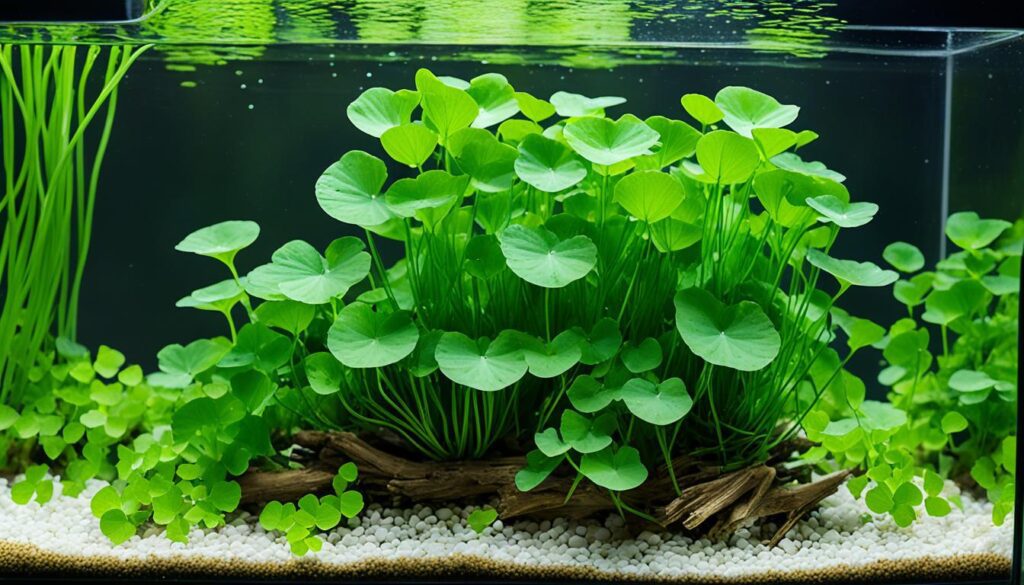
If you love aquatic gardening, you’ll find Pennywort incredible. It grows well in many tank types, from fancy to low-tech aquariums. Knowing Pennywort growth strategies is key to success.
Light conditions matter a lot. Pennywort does great in both bright and dim lights. This makes it ideal for low-tech aquarium setups. Water conditions are flexible too. The best temperature is 20℃ to 28℃ and pH of 6.0 to 7.0, but Pennywort can handle slight changes.
Be careful with plant fertilization. Choose fertilizers made for water plants. Avoid those with harmful chemicals or too much nutrients. Pennywort also helps keep the tank clean by lowering nitrate levels. This makes the water better for fish.
- Rapid Growth: Pennywort grows fast. Regular cutting is needed to stop it from spreading too much. This helps the plant grow stronger and keeps the tank neat.
- Plant Placement Flexibility: You can let it float or root it in the ground. Pennywort adjusts fast, making better homes and breeding spots for fish.
- Reduction in Nitrates: Pennywort helps remove nitrates from the water. This improves water quality and helps fish stay healthy.
Pennywort is easy to care for and great for beginners or pros. It’s perfect for any fish tank. Adding Pennywort makes your setup more beautiful and healthy for all living things in it.
Pruning Pennywort to Maintain a Healthy Tank
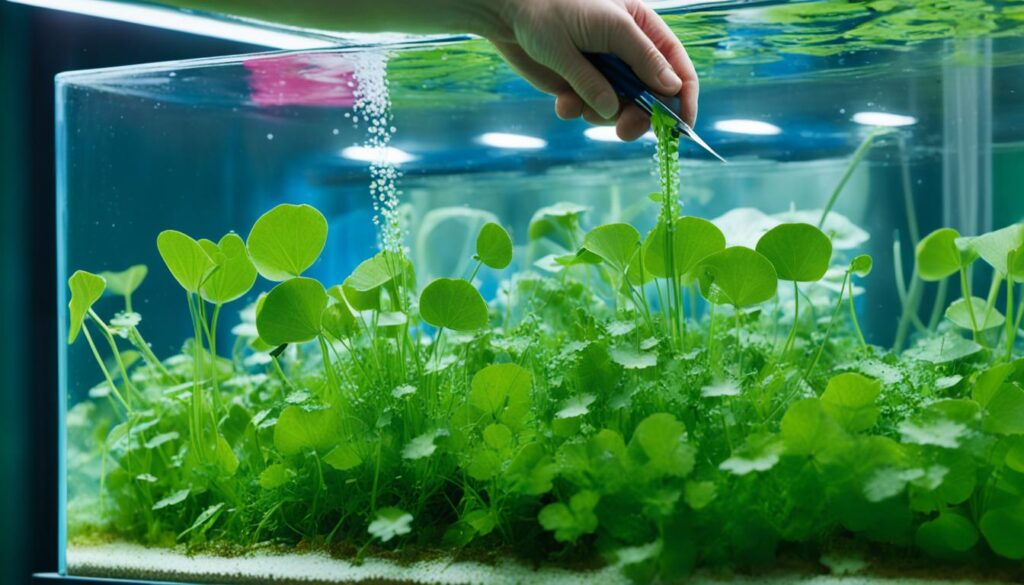
It’s important to keep your tank healthy, and regular pennywort pruning is a big part of that. This process helps your tank stay neat. Plus, it supports the growth and health of this flexible plant.
Effective Trimming Techniques
Trimming aquatic plants requires care to avoid damage. Use sharp shears and cut above a leaf joint. This encourages new growth and keeps cuts clean, preventing stem tears. It’s a key to keeping your pennywort and tank healthy.
Regeneration After Pruning: Encouraging Growth
After being cut, pennywort can regrow impressively. A piece with just one leaf and a stem can grow roots and thrive again. This helps maintain your aquarium’s look and balance.
Property |
Details |
|---|---|
Plant Name |
Brazilian Pennywort (Hydrocotyle leucocephala) |
Origin |
South America |
Optimal pH |
6.0-7.8 |
Light Intensity |
Moderate |
Water Hardness |
Moderate |
Temperature Range |
68-82°F |
Reviews |
4 x 5-star, 1 x 4-star |
Knowing how to prune pennywort right can make your aquarium healthier and prettier. With proper tools and methods, you can create a vibrant water garden.
Finding Pennywort for Your Aquarium: Purchase Tips
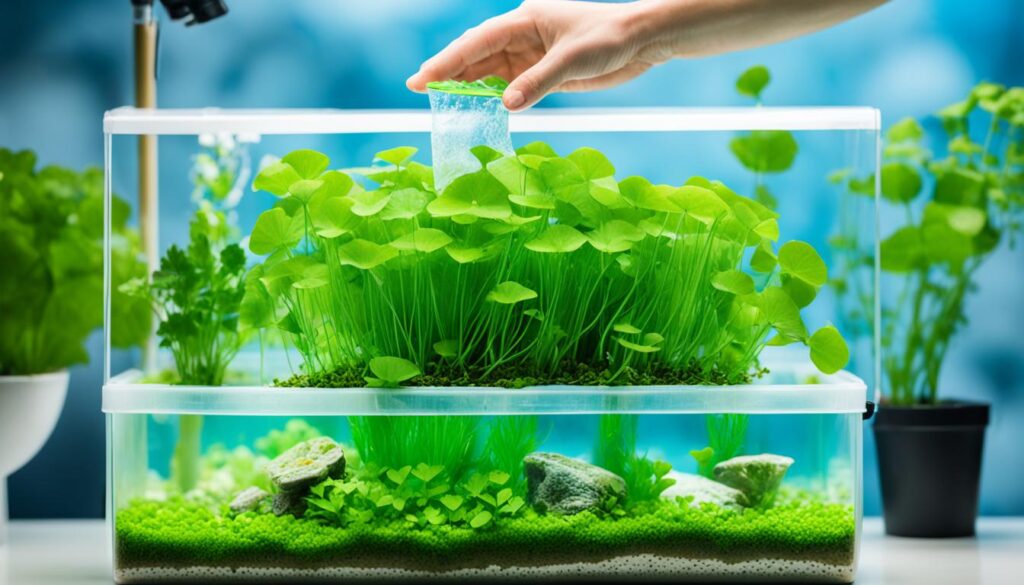
When I decided to add Pennywort to my aquarium, I knew I had to find it responsibly. This ensures the health and beauty of my aquatic setting. Here’s what I learned to help you buy the best Pennywort for your tank.
Understanding Pennywort is key. It’s known as Hydrocotyle leucocephala and comes from places like Brazil. It grows in swamps and streams, showing it can adapt to different aquatic settings. Make sure you buy from aquarium plant sellers who are credible and know their stuff.
Look for sellers who offer detailed plant care and origin info. Good Pennywort has bright green leaves and strong stems. Avoid plants that look wilted or have discolored leaves; these signs mean the plant is likely unhealthy.
- Check the plant’s health by looking for crisp leaves.
- Its roots should be big but not too tangled.
Talk to the seller about how to take care of Pennywort. It likes a pH of 5.0 to 7.0 and temperatures between 65°F to 80°F. Sellers who know this show they are trustworthy in aquarium plant sourcing.
Choosing quality Pennywort is crucial for your aquarium’s success. Taking time to find the right seller for buying Pennywort will help your aquarium thrive.
Combatting Common Pennywort Diseases
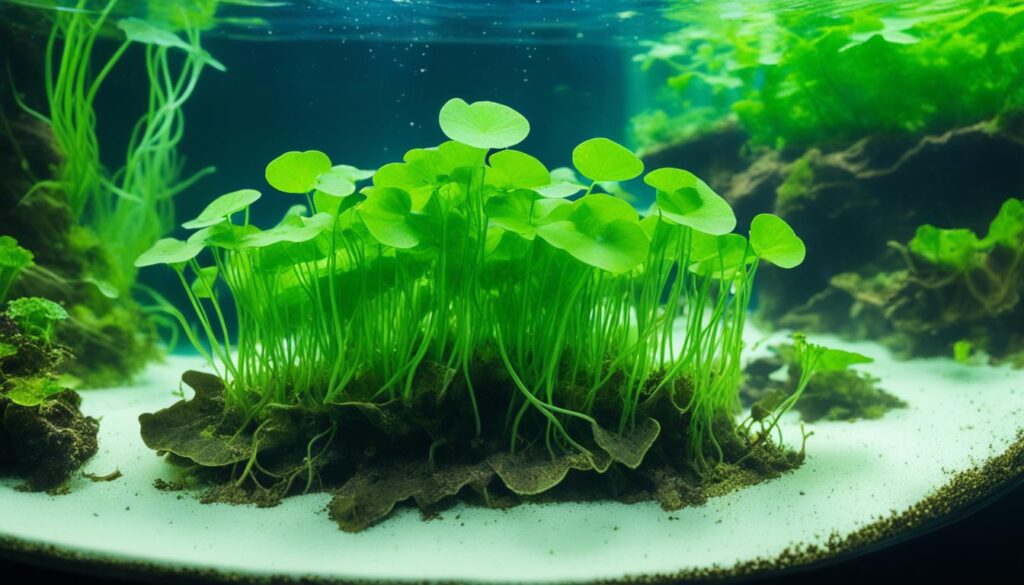
Caring for an aquatic environment is challenging, especially with pennywort diseases. Understanding and treating these conditions is key to keeping pennywort healthy. This guide focuses mainly on dealing with iron deficiency.
Yellowing leaves on pennywort often mean there’s not enough iron. Iron is vital for making chlorophyll, which pennywort needs for photosynthesis. You can fix this by adding special supplements for aquatic plants to your care routine.
Pennywort diseases aren’t just about lacking nutrients. Issues can also arise from water and the environment, like overwatering or too much humidity. This can cause fungal infections. To avoid these problems, keep your aquarium within the ideal temperature of 60-85°F (15-29°C).
- Regularly check and adjust water conditions
- Use the best water conditioners and plant foods
- Make sure your plants get the right amount of light, which is usually bright but indirect
Keeping a care log has helped me spot and fix health issues with my aquarium plants early. This lets me tweak my routine before problems get worse.
Condition |
Symptoms |
Preventative Measures |
|---|---|---|
Overwatering |
Leaves turn into mushy, soft dark brown spots |
Monitor water levels, ensure proper drainage |
Underwatering |
Leaves dry, crispy with lighter brown patches |
Check soil moisture often |
Fungal Infections |
Poor growth, soft discolored spots on leaves |
Manage humidity, improve air flow |
Nitrogen Deficiency |
Leaves have brown spots, plant grows slowly |
Use nitrogen-rich plant food |
Iron Deficiency |
Yellow or pale leaves, plant is weak |
Add chelated iron to water |
Improving pennywort health and avoiding diseases requires more than just reacting to problems. Being proactive and monitoring your aquarium’s environment is key. Healthy pennywort plants make your aquarium look better and help keep the ecosystem balanced.
Pennywort Plant Positioning and Tank Beautification
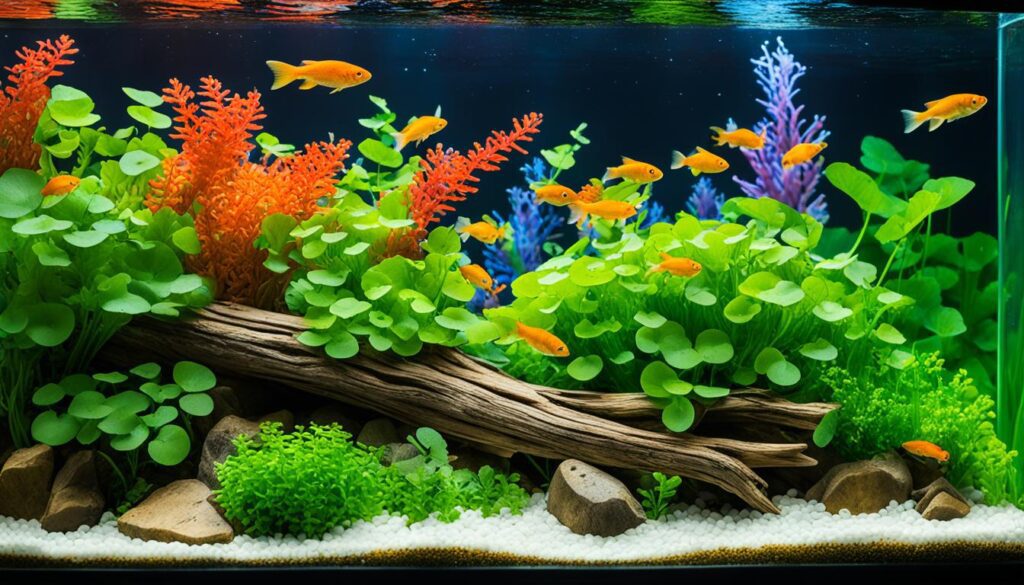
Putting Pennywort in your aquarium boosts its look and helps the tank’s environment. Adding Pennywort tank aesthetics and aquarium design makes any tank lively. This approach turns a basic tank into a thriving ecosystem.
The Value of Plant Placement
Choosing where to place Pennywort in your tank is a big deal. It’s not only for looks but helps baby fish grow. It keeps the water perfect for fish to stay healthy. Pennywort does great even in dim light, so you can put it almost anywhere. This makes it loved by both beginners and pros at fish keeping.
Creating a Nursery with Pennywort
By using Pennywort as a floating plant nursery, you give baby fish a safe spot. This boosts their chances to survive. The plant also controls light levels, which is good for fish that like it dim.
Looking at different plants shows how key their placement is:
Plant Name |
Max Size |
Light Requirement |
Growth Response |
|---|---|---|---|
Crypts |
6 inches |
Low light |
Stable, easy management |
Water Wisteria |
Varies |
Low to moderate light |
Adjusts form based on light |
Dwarf Rotala |
Small |
Low light |
Adds color, low light survivor |
Brazilian Pennywort |
Varies |
Flexible |
Effective as floating or rooted |
Mixing these plants with Brazilian Pennywort makes your aquarium look stunning. Putting them together ensures beauty and a healthy water world.
Using these ideas, you can make a tank that’s not just pretty but also good for the fish. Pennywort nurseries make tanks more beautiful. They also help you redesign your aquarium for vibrant, healthy underwater life.
The Remarkable Advantages of Adding Pennywort to Your Tank
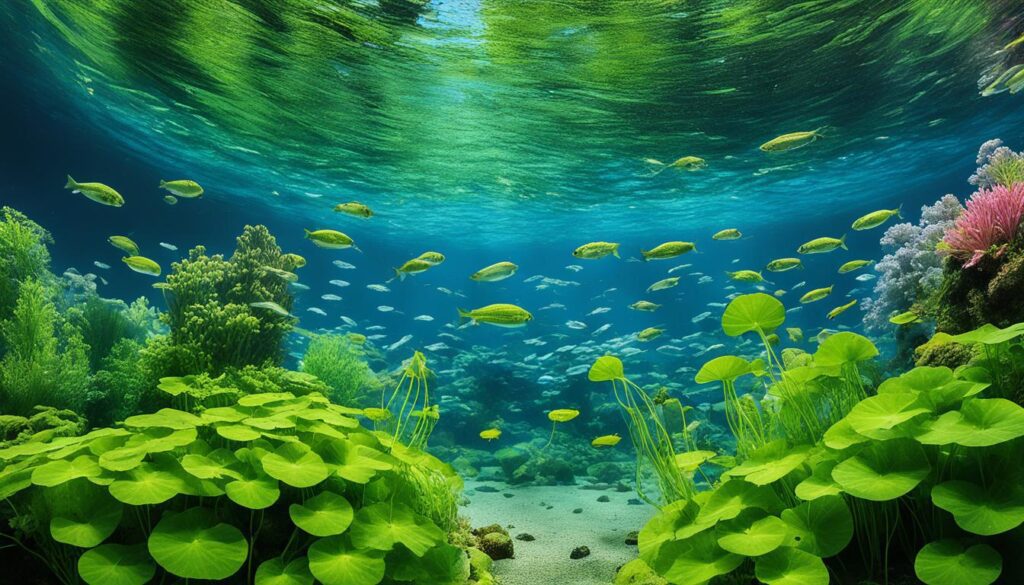
Adding Pennywort to your tank brings many perks. It makes your tank look better and helps keep its environment balanced. This plant has lush, green leaves and is more than just eye candy. It cleans the water and keeps your tank healthy.
Nitrate Reduction and Water Quality Control
Pennywort is great at removing nitrates. These are bad for fish at high levels. Other plants might not do well with nitrates, but Pennywort uses them to grow. This makes it a natural way to keep your water clear and safe for fish.
Pennywort’s Role in Aquatic Life Breeding
Pennywort also helps fish and other creatures have babies. It provides safe places for laying eggs and hiding fry. This means more baby fish can survive. Pennywort helps keep young fish safe, making it perfect for breeding.
Pennywort does well in different light and water conditions. It grows fast and helps clean the water. Anyone, from beginners to experts, can use it in their tanks.
Feature |
Benefits |
|---|---|
Water Purification |
Reduces nitrates, improves overall water quality |
Breeding Support |
Provides natural breeding grounds and protection for fry |
Adaptability |
Thrives in a range of light and water conditions |
Pennywort does more than just look good in your aquarium. It helps control nitrate levels and supports aquatic life. This plant is key in keeping your aquatic ecosystem healthy.
Your Next Steps: Cultivating a Lush Pennywort Aquascape
Starting your planted aquarium journey is exciting. It’s all about making your water world look amazing. First, learn about the Pennywort plant. It’s great because it cleans the water by taking in bad stuff like ammonia. I’ve learned that choosing good soil or gravel and being dedicated to cleaning the tank are crucial.
LED lights are key for growing Pennywort. They give the right kind of light without heating the water too much. Adding a CO2 system and the right food helps your Pennyworts grow strong. Before putting these plants in, make sure your tank is ready. This helps keep things balanced for the plants and fish. Plants like Egeria Densa and Hydrocotyle Leucocephala grow fast. They help keep the water clean and fight algae.
Creating a successful tank is more than just looks. It’s about making a place where water creatures and plants live together well. Whether you’re new or experienced in aquascaping, taking good care of your plants is key. Trim them, check the water, and change it as needed. This will make your Pennywort aquarium a beautiful, calming place to watch.
